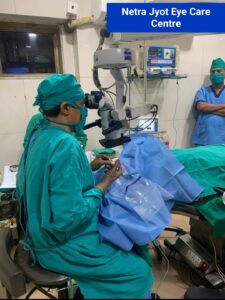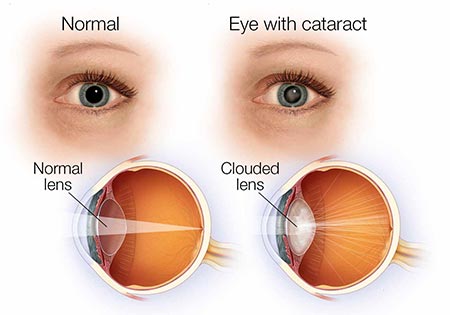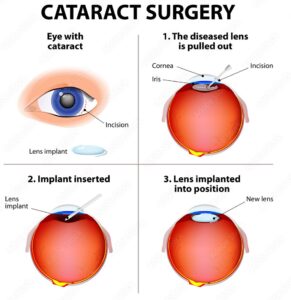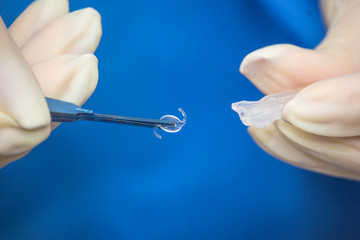
Hey Friends; I am Dr Ashesh Gala welcome you to Netrajyot Eye Care Centre’s interactive blog on cataract surgery in Mumbai!
What is a cataract?

I will explain it to you with our day-to-day example.
Have you ever noticed an old car with foggy or hazy headlights?
Just like how the car headlights become foggy over time, the natural lens of our eye can become cloudy and opaque, leading to a condition called cataracts.
Cataracts are a common eye condition that affects many people, especially as they get older.
They can also occur in younger people due to various factors such as diabetes, trauma to the eye, or prolonged use of certain medications.
Cataracts can cause a range of symptoms, including blurry or cloudy vision, difficulty seeing at night, seeing halos around lights, and even double vision.
While cataracts are a natural part of ageing, they can significantly affect a person’s quality of life.
However, the good news is that cataracts can be treated with a simple surgery that removes the cloudy lens and replaces it with an intraocular lens implant.
Cataract surgery

Cataract surgery is a common procedure that involves the removal of the cloudy lens from the eye and replacement with an artificial lens.
In this blog, we will discuss;
1. Intraocular Lenses (IOLs) in cataract surgery & the different types of lenses used in cataract surgery
3. Premium Lenses
4. Cataract surgery cost
5. After cataract surgery precautions
1. Intraocular Lenses (IOLs) in cataract surgery
Intraocular lenses (IOLs) are artificial lenses that are implanted inside the eye during cataract surgery.
Cataracts are a common condition in which the natural lens of the eye becomes cloudy, causing blurred vision and other visual disturbances.
During cataract surgery, the cloudy lens is removed and replaced with an Intraocular lens- IOL, which helps to restore clear vision.
Intraocular lenses -IOLs are made of a biocompatible material that is safe for use inside the eye.
They are available in different materials, designs, and focusing powers, allowing for customized treatment options for each patient.
Some Intraocular lenses – IOLs even have special features, such as blue light filtering or multifocal capabilities, that can further improve visual outcomes.
Overall, IOLs have revolutionized cataract surgery and have greatly improved outcomes for patients.
They allow for improved vision and a faster recovery time, as patients no longer need to rely on thick glasses or contact lenses after surgery.
2. Different types of lenses used in cataract surgery-

First, let’s discuss the different types of IOLs used in cataract surgery.
There are three types of lenses – monofocal, multifocal, and toric.
Monofocal lenses provide clear vision at one distance, usually for distance vision, and require patients to wear glasses for other distances.
Multifocal lenses can provide clear vision at multiple distances, reducing or eliminating the need for glasses.
Toric lenses are designed to correct astigmatism, a common condition where the eye’s shape is irregular, resulting in distorted or blurry vision.
3. Premium Lenses-
Premium lenses are also available for cataract surgery.
These lenses can correct presbyopia, a condition that causes difficulty in focusing on objects up close as we age.
They are also designed to reduce glare and improve vision in low-light conditions.
However, premium lenses are more expensive than traditional lenses, so it is important to discuss the cost and benefits with your ophthalmologist.
4. Cataract surgery cost

The cost of cataract surgery can vary depending on the type of lens used, the surgeon’s experience, and the location of the clinic.
In Mumbai, the cost of cataract surgery can range from Rs. 20000/- to Rs. 1,30000/-,per eye.
It is important to note that insurance may cover some or all of the cost of cataract surgery.
5. After cataract surgery precautions

After cataract surgery, it is important to take some precautions to ensure a smooth recovery.
Patients should avoid rubbing their eyes, participating in strenuous activities, and exposing their eyes to water for a few days after surgery.
Patients should also use eye drops as prescribed by their ophthalmologist and attend follow-up appointments to monitor their progress.
I also want to emphasize the importance of regular eye checkups, especially for individuals above the age of 60.
Cataracts are common among the elderly and can significantly affect their quality of life. However, early detection and treatment can prevent further vision loss and improve overall eye health.
Netrajyot Eye Care Centre
At Netrajyot Eye Care Centre we offer comprehensive eye care services, including cataract surgery and IOL implantation.
We use the latest technology and technique to ensure the best outcomes for our patients.
If you or a loved one is experiencing vision problems or has been diagnosed with cataracts, don’t hesitate to schedule an appointment with us.
Our team of experts will provide personalized care and guide you through every step of the process.
Remember, cataract surgery is a safe and effective procedure that can significantly improve vision and quality of life.
With the advancements in technology and the availability of premium lenses, patients now have more options than ever before.
If you are considering cataract surgery, it is important to discuss your options with your ophthalmologist and ask any questions you may have.
Conclusion-
In conclusion, IOLs are an important part of cataract surgery and can significantly improve vision. Monofocal lenses are the most common, but multifocal and toric lenses are also available.
Premium lenses can provide additional benefits but are more expensive. Cataract surgery costs can vary, but insurance may cover some or all of the cost. . After surgery, taking precautions and attending follow-up appointments can ensure a smooth recovery.
Intraocular lenses have revolutionized cataract surgery and can significantly improve vision and quality of life. The type of lens used and the cost of the surgery can vary, so it is important to discuss all options with your ophthalmologist. Taking precautions and attending follow-up appointments can ensure a smooth recovery. Regular eye checkups are also essential for maintaining good eye health.
Thank you for reading my interactive blog on intraocular lenses in cataract surgery. I hope that it has been informative and helpful in addressing any questions or concerns you may have had about this procedure.
Also, let me know; What topics would you like me to cover in future blogs?

